March 25, 2023 | Posted by MICRO

By Karoly Ban Matei
Presented by Moldex
Hearing loss is one of many safety issues that permeate almost every workplace but is seldom discussed in the open. The Centers for Disease Control and Prevention (CDC)estimates that roughly 22 million Americans are exposed to hazardous noise levels at work. Additionally, the Hearing Loss Association of America estimates that of the 48 million Americans suffering from some degree of hearing loss, about 60% have been exposed in the workplace or educational institutions.
In addition to being difficult on workers and their health, all this noise exposure is costly. The Department of Labor estimates that the annual cost of workers’ compensation for hearing loss is around $242 million, while the impact of the US economy might be as high as $18 billion (in unrealized federal income taxes due to reduced earning potential – people with unaided hearing loss earn on average $20,000 less annually less than those wearing hearing aids).
Protecting workers from noise-induced hearing loss requires a set of interventions at every level. Engineering and administrative control methods – such as purchasing quieter machinery or scheduling works tasks to ensure workers are not exposed to noise hazards for lengthy, uninterrupted periods – are important, but it’s rarely possible to entirely eliminate dangerous noise levels from the work site. This is where hearing protection PPE comes in. It gives workers direct protection from the noise in their environment.
(Learn more about The Hierarchy of Hazard Controls.)
This article will cover the relevant legislation and standards regulating the use of hearing protection PPE in the workplace, as well as how to select the right type of PPE for a given job. We will also look at some commonly overlooked aspect of hearing protection to get a better picture of how to keep workers safe from noise.
Legislation
The General Duty Clause of the Occupational Health and Safety Act applies to hearing protection. It stipulates, in Section 5(a)(1), that he employer is responsible for “furnish[ing] to each of his employees employment and a place of employment which are free from recognized hazards that are causing or are likely to cause death or serious physical harm to his employees.”
The standard 1910.95, Occupational Noise Exposure (generic industry), deals exclusively with noise exposure and covers, among other things, the need for:
- An employer to have a hearing conservation program when “employee noise exposures equal or exceed an 8-hour time-weighted average sound level (TWA) of 85 decibels.”
- The employer to establish a monitoring program for the employees subjected to the above-mentioned conditions.
- The employer to provide an audiometric test program at no cost to employees.
- The employer to provide hearing protectors appropriate for the noise intensity and the task at hand, and for the employee to wear these protectors. The company has to ensure initial proper fitting of PPE and supervise the employees to ensure they are using the hearing protectors as intended, while allowing their input in the selection of the PPE.
(For more about proper fit, see Are You Wearing Your Earplugs Properly?)
The construction industry has its own standard (29 CFR 1926), which addresses Occupational Noise Exposure in standard 1926.52 and Hearing protection in 1926.101.
Although the 1910.95 standard is fairly extensive, it can be considered only a minimum standard, since there are 28 OSHA approved State Plans (22 State Plans covering both public and private sectors and 6 State Plans covering the public sector only) that go beyond these minimum requirements.
Besides OSHA there are also some other federal agency standards regarding noise protection:
What Hearing Protection Is Right for Me?
As seen from 1910.95, employees have a say in selecting hearing protection. Because it’s not entirely up to the employer, you might feel overwhelmed when presented with options.
As with any PPE, hearing protection has to be appropriate for the task at hand. Your most important concern should be choosing hearing protection that is able to reduce the noise pressure perceived by your ear below the 85 db threshold.
A great tool for determining how much a hearing protection device will reduce the noise intensity is the Noise Reduction Rating (NRR). You will find this number marked on most earplugs and earmuffs. Generally, earplugs offer higher protection than earmuffs, with the highest rating for earplugs being 33, while the highest rating for earmuffs stands at 31. Combining earplugs with earmuffs, however, can provide an NRR of 36.
Unfortunately, estimating the perceived noise with a specific hearing protection is not as simple as subtracting the NRR from the level of environmental noise. If the noise in your work area is 95 db and your earplug NRR is 25, the noise, as perceived by your ear, will be 86 db (and not 75). This is because NRR is de-rated to account for fit and other factors. To get the number of decibels that the noise will be reduced by, you will have to subtract 7 from then NRR and divide the result by 2. Then you can subtract that number from the workplace noise level and you will get the level of exposure after the protection is applied.
Let’s do the calculation for the above-mentioned example:
- Workplace noise: 95 db
- NRR for your earplugs: 25
- De-rated NRR is (25-7)/2 = 9
- Perceived noise with your earplugs: 95-9 = 86 db
When combining 2 hearing protections (earplugs plus earmuffs) add 5 to the higher NRR to obtain the combined NRR for the pair. So, if your earplugs have an NRR of 31 and your earmuffs have an NRR of 27, the combined NRR is 36 (31+5).
Let’s re-do the calculation for the earlier example:
- Workplace noise: 95 db
- Combined NRR: 35
- De-rated NRR is (35-7)/2 = 14
- Perceived noise with your earplugs: 95-14 = 81 db
When deciding what type of hearing protection you want, besides the NRR you will also have to consider:
- What works best for the job, including:
- How often it needs to be donned and doffed
- Potential entanglement with equipment
- Contact with substances in the workplace
- Yours and your employees’ personal preferences
Pros and Cons of Different Types of Hearing Protection:
Expandable Foam Plugs
Pros: Affordable, widely available, fits most people
Cons: People with narrow ear canals can find them painful; removing them can contaminate them
Pre-molded Reusable Plugs
Pros: Reusable, available in different sizes, washable, no need to roll the tip (as with foam plugs) which eliminates contamination hazard
Cons: While fairly cheap, they are still more expensive than foam earplugs
Canal Caps
Pros: Quick to put on or take off, designed to block more noise than earplugs (because of the pressure of the headband)
Cons: Some users find band uncomfortable and it may also get caught in equipment
Earmuffs
Pros: Comfortable, easy to don and doff, might have noise cancellation technology
Cons: Hot and heavy in some environments, sideburns and glasses might interfere with the seal
When to Measure
According to 1910.95 (d)(3), you should perform a new monitoring whenever there are changes in your production, process, equipment, or controls.
That being said, you should use some discretion. If any changes have the potential to produce noise, monitoring is warranted.
Overlooked Aspects of Hearing Protection
Hearing protection seems simple enough, but there are some subtle things that often get missed. Let’s look at a few of the misconceptions associated with hearing protection:
- Subtracting the NRR: Before calculating the noise exposure to a worker with ear protection, it’s important to de-rate the NRR (as discussed above) to ensure workers are not underprotected
- Overprotection Can Be Hazardous: There is sometimes a “better safe than sorry” attitude when it comes to PPE, but giving workers too much hearing protection can itself be a hazard since it will block ambient noise that could signal the presence of danger (e.g. vehicle horn, equipment sound, evacuation signal)
- Double Hearing Protectors Does Not Equate to Double Protection: Earplug and earmuff combinations provide greater protection than just one type of PPE on its own, but it only adds 5 to the NRR
- Not Everyone Knows How to Use Hearing Protection: Many safety professionals pass along hearing protection, especially earplugs, assuming that everyone knows how to use them instead of providing appropriate training
- People with Hearing Loss Still Need Hearing Protection: Hearing loss is a chronic condition that develops over time, which means that it can be aggravated by continued exposure to hazardous noise levels
- Hearing Loss Is Not Always Noise-Induced: Hearing loss can be induced by other stressors, such as severe variations in pressure and even smoking – your hearing protection program should look beyond PPE
- There Is Stigma Associated with Hearing Loss: Not everyone is comfortable revealing that they have difficulty hearing, which means that we cannot assume that every employee has understood all of the training, messages, and step-by-step instructions that have been delivered to them – to ensure their safety, we must verify that they have understood what has been conveyed to them
Conclusion
Hearing loss is one of the most common long-term disabilities in the workplace. While most of us know the facts about hearing loss, many of us know them only superficially. Often, the true culprit for hearing loss is our own ignorance. Since hearing loss is irreversible, knowing how to select, use, and care for hearing protection PPE is essential.


